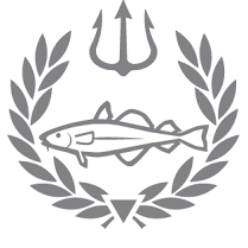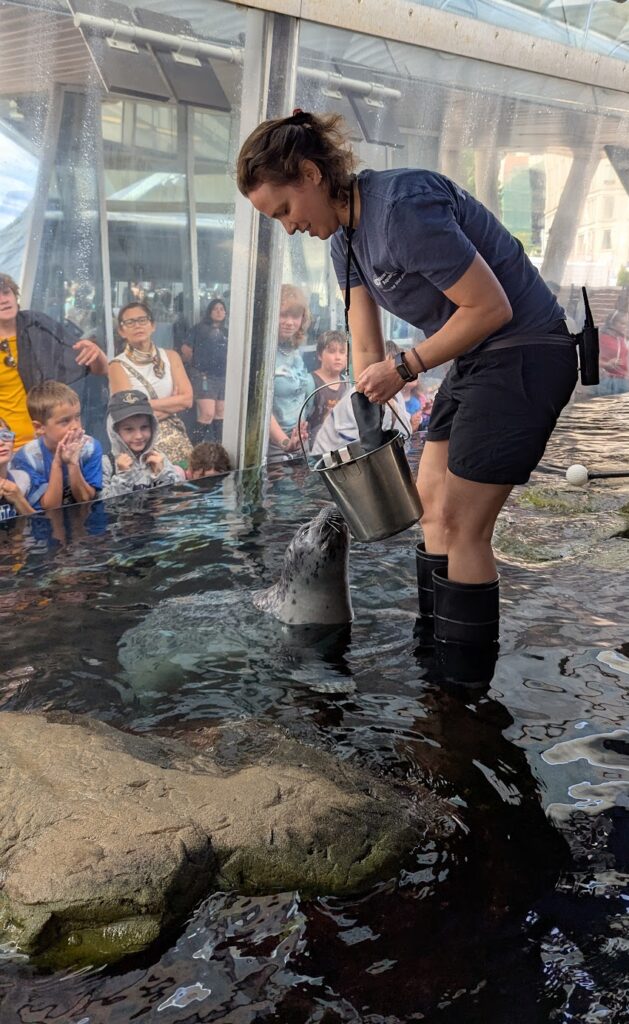When I showed up to the aquarium for my day shadowing the Animal Health Department, I didn’t go inside the building for an hour after I arrived. The harbor seal exhibit by the ticket booths outside the aquarium had been completely drained that morning, and the animal health team was inside with some of the pinniped trainers, doing blood work on the seals. As I learned from the pinniped staff also observing the blood draw, the seals’ blood is taken and tested twice per year to make sure everything is running smoothly.  All the aquarium’s harbor seals have exceeded their natural life expectancy of 20 years by a decade or more, mostly thanks to the medical care they are able to recieve at NEAq. For example, in addition to the blood draw, the seal Reggae needed an eye exam and some extra fluids so they had also brought IV bags for him.
All the aquarium’s harbor seals have exceeded their natural life expectancy of 20 years by a decade or more, mostly thanks to the medical care they are able to recieve at NEAq. For example, in addition to the blood draw, the seal Reggae needed an eye exam and some extra fluids so they had also brought IV bags for him.
Back inside the aquarium, I was shown around the Animal Health Department on the fourth floor and officially met the AHD team: veterinarian Melissa, and vet techs Mary Beth and Alyssa. There’s a surgery suite and a radiology room right there in the AHD department! The only animal living back there at the moment was a pork fish from the GOT that had been removed after getting attacked by some of the other GOT fish. The GOT and AHD teams decided to give him space and treatment to heal and to try and figure out why he might be getting targeted. Soon, Abi from the GOT joined us for porkfish treatment time: sedating him, taking an X-ray, and giving him his injections before putting him back into his holding tank.
Soon enough it was time to break for lunch, after which I had some time to explore the aquarium before meeting back with the AHD folks to observe their eye exam on one of the African penguins, Aewa. She’s in the middle of her molt so the penguin trainers had to be careful not to get her too wet as they brought her to the platform. The last thing I got to see that day was a necropsy on a weedy sea dragon that had passed away. The aquarium does necropsies on all the animals that pass, so Mary Beth was kind enough to bring me into the room and explain what they were doing as they did the procedure.
It was really interesting to see how much the Animal Health Dept does! They interact with all different parts of the aquarium and with all different types of animals. I’m really grateful I got to see so much, especially the harbor seal bloodwork.
Speaking of the harbor seals, Thursday was my day with the Pinnipeds team!! The New England Aquarium has harbor seals and southern sea lions. In the morning, I helped with food prep, inspecting and cutting the fish and squid for both the seals and sea lions. When that was done, we headed across the aquarium to the seal exhibit (full of water again) for training. I got to walk all the way down the exhibit to sit with trainer Mollie, with Trumpet and Chacoda (a mother and son in the “spotted family,” one of the two harbor seal families). I was really impressed with how extremely well trained they both were! Granted, they’ve had 30-40 years of training from professional animal behaviorists, so it makes sense. They were so well-behaved that Mollie had me feed Trumpet some fish as a reward and got kisses from both the seals!
After seal training, it was time for the sea lion talk! The pavilion at the back of the aquarium was packed. Two of the trainers came out and walked sea lions Farley and Sierra through different skills and behaviors while Mollie gave a talk about sea lions, training techniques, and ways to help wild sea lions.
Then, I helped Thayna, the intern I helped food prep with, put together some toys (complete with fish and scent) for the seals, delivering them and watching the seals engage with them before taking them back to get ready for the next sea lion talk. There’s a second area behind the scenes where the rest of the sea lions spend time while two or three are out in the exhibit, so Farley had been brought back there. This time it was Sierra and Gio who were on exhibit and they did some really cool skills. Gio is working on a backflip!
Back in the behind-the-scenes area, Alyssa from AHD was with some of the trainers as they practiced some procedures with Farley. It’s important for the animals to participate in their own healthcare by being familiar with what is asked of them during procedures. Rather than sedating or subduing the pinnipeds, the aquarium trainers positively reinforce the behavior Farley needs for giving blood: laying on his side, flipper out, holding still while people touch and prick him. He did great, and they rewarded him with tons of fish and some jello as a treat.
Once again, I am incredibly grateful for the day I had at the New England Aquarium. The pinniped trainers were wonderful, and always willing to include me in whatever they were working on. I’m so glad I had the opportunity to learn from them!
– Sofia



